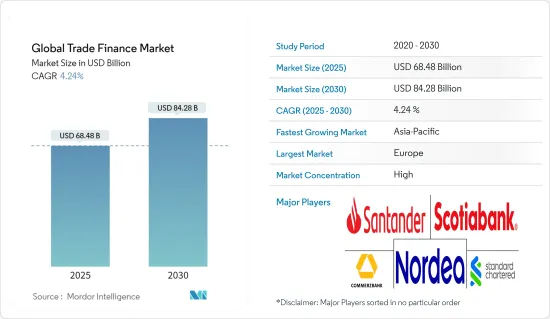PUBLISHER: Mordor Intelligence | PRODUCT CODE: 1690713

PUBLISHER: Mordor Intelligence | PRODUCT CODE: 1690713
Global Trade Finance - Market Share Analysis, Industry Trends & Statistics, Growth Forecasts (2025 - 2030)
The Global Trade Finance Market size is estimated at USD 68.48 billion in 2025, and is expected to reach USD 84.28 billion by 2030, at a CAGR of 4.24% during the forecast period (2025-2030).

SMEs' adoption of trade finance in developing countries increased due to the need to ensure smooth trading activities. Factors like increased competition and new trade agreements are supporting the trade finance market growth. The surge of trade wars and high-cost implementation also supports the market's development. Since the trade finance industry integrates with blockchain technology, it provides opportunities for the global market to expand.
The emerging trend of sustainable finance in the trade finance industry is the growing element of environmental, social, and governance (ESG) principles. Businesses and financial institutions are highly incorporating sustainability in trade finance decisions. The popular sustainable trade finance instruments are green bonds and ESG-linked loans. The integration of sustainable finance practices in the trade finance industry became popular due to the rising awareness about climate and social issues.
The rapid growth of advanced technology and digitalization supports the global market's growth. Traditional paper-based processes gave way to digital solutions. Blockchain technology introduced transparency and security into supply chain finance and trade settlements to reduce fraud and errors. To enhance risk assessment and make more accurate credit decisions for facilitating the financing gap for small and medium-sized enterprises (SMEs), artificial intelligence (AI) technology and data analytics were introduced. Fintech start-ups raised innovative digital platforms to make them more accessible and affordable.
Trade Finance Market Trends
Globalization And Increased International Trade Drives the Market
The rapid increase in globalization and rising volume of international trade support the market growth. To enter global markets, businesses need efficient and secure financing solutions for cross-border transactions. Due to the expansion of supply chains in multiple countries, the demand for trade finance is increasing. This trend has been further created by the rise of e-commerce platforms, which helped businesses enter international trade. The demand for trade finance services is increasing due to the interconnectivity of economies and the emergence of new market opportunities.
North America Dominates the Global Trade Finance Market Share
North America has a strong economy and considerable volume of international trade. North America became a hub for trade finance activities due to its robust financial infrastructure and well-established banking institutions. Businesses in North America benefited from a vast range of trade finance services such as letters of credit, export financing, and risk mitigation solutions. The region's rising technological innovation and digitalization are increasing the market's growth.
According to this market analysis report, North America represents a well-developed trade finance market. Businesses adopt trade finance instruments to smoothen trade within the region and with global partners. The emergence of sustainable finance and environmental, social, and governance (ESG) principles in trade finance occurred in North America. Hence, these are the factors leading the trade finance market' share growth.
Global Trade Finance Market Overview
The trade finance market is competitive. The rapid adoption of advanced technologies like machine learning, blockchain, AI, and IoT is increasing the market's growth. The largest companies in the global market are focusing on product development to expand their geographical presence and increase competition among local vendors in terms of features, quality, and price. The largest companies are Santander Bank, Scotiabank, Commerzbank, Nordea Group, and Standard Chartered Bank.
Additional Benefits:
- The market estimate (ME) sheet in Excel format
- 3 months of analyst support
TABLE OF CONTENTS
1 INTRODUCTION
- 1.1 Study Assumptions and Market Definition
- 1.2 Scope of the Study
2 RESEARCH METHODOLOGY
3 EXECUTIVE SUMMARY
4 MARKET INSIGHTS AND DYNAMICS
- 4.1 Market Overview
- 4.2 Market Drivers
- 4.2.1 Rise In Global Trade Drives The Market
- 4.2.2 Increasing Investments And Innovations In Fintech Drives The Market
- 4.3 Market Restraints
- 4.3.1 Risk Concerns on Uncertainty With Respect To Investments Which Negatively Impacts On Financial Welfare
- 4.3.2 Complexities In Trade Finance Transactions
- 4.3.3 Market Opportunities
- 4.3.3.1 Technological Advancements In Trade Finance Market
- 4.4 Industry Value Chain Analysis
- 4.5 Industry Attractiveness: Porter's Five Forces Analysis
- 4.5.1 Threat of New Entrants
- 4.5.2 Bargaining Power of Buyers
- 4.5.3 Bargaining Power of Suppliers
- 4.5.4 Threat of Substitutes
- 4.5.5 Intensity of Competitive Rivalry
- 4.6 Insights On Technology Innovation In The Market.
- 4.7 Impact of COVID-19 on the Market
5 MARKET SEGMENTATION
- 5.1 By Service Provider
- 5.1.1 Banks
- 5.1.2 Trade Finance Companies
- 5.1.3 Insurance Companies
- 5.2 By Geography
- 5.2.1 North America
- 5.2.1.1 US
- 5.2.1.2 Canada
- 5.2.1.3 Mexico
- 5.2.1.4 Rest of North America
- 5.2.2 Europe
- 5.2.2.1 Germany
- 5.2.2.2 UK
- 5.2.2.3 France
- 5.2.2.4 Russia
- 5.2.2.5 Spain
- 5.2.2.6 Rest of Europe
- 5.2.3 Asia-Pacific
- 5.2.3.1 India
- 5.2.3.2 China
- 5.2.3.3 Japan
- 5.2.3.4 Rest of Asia-Pacific
- 5.2.4 South America
- 5.2.4.1 Brazil
- 5.2.4.2 Argentina
- 5.2.5 Middle East And Africa
- 5.2.5.1 UAE
- 5.2.5.2 Saudi Arabia
- 5.2.5.3 Rest of Middle East And Africa
- 5.2.1 North America
6 COMPETITIVE LANDSCAPE
- 6.1 Market Concentration Overview
- 6.2 Company Profiles
- 6.2.1 Citi group Inc.
- 6.2.2 Santander Bank
- 6.2.3 Scotiabank
- 6.2.4 Commerzbank
- 6.2.5 Nordea Group
- 6.2.6 Unicredit
- 6.2.7 Standard Chartered Bank
- 6.2.8 Arab Bank
- 6.2.9 Societe Generale
- 6.2.10 Rand Merchant Bank
- 6.2.11 Rabobank
- 6.2.12 China Construction Bank
- 6.2.13 BNP Paribas*
7 MARKET FUTURE TRENDS
8 DISCLAIMER AND ABOUT US




